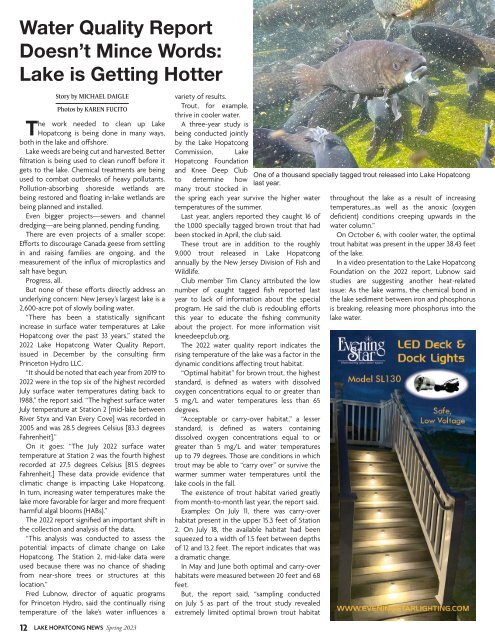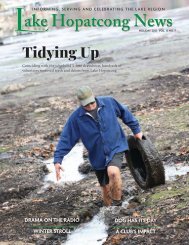Spring 2023 Issue
Create successful ePaper yourself
Turn your PDF publications into a flip-book with our unique Google optimized e-Paper software.
Water Quality Report<br />
Doesn’t Mince Words:<br />
Lake is Getting Hotter<br />
12<br />
Story by MICHAEL DAIGLE<br />
Photos by KAREN FUCITO<br />
The work needed to clean up Lake<br />
Hopatcong is being done in many ways,<br />
both in the lake and offshore.<br />
Lake weeds are being cut and harvested. Better<br />
filtration is being used to clean runoff before it<br />
gets to the lake. Chemical treatments are being<br />
used to combat outbreaks of heavy pollutants.<br />
Pollution-absorbing shoreside wetlands are<br />
being restored and floating in-lake wetlands are<br />
being planned and installed.<br />
Even bigger projects—sewers and channel<br />
dredging—are being planned, pending funding.<br />
There are even projects of a smaller scope:<br />
Efforts to discourage Canada geese from settling<br />
in and raising families are ongoing, and the<br />
measurement of the influx of microplastics and<br />
salt have begun.<br />
Progress, all.<br />
But none of these efforts directly address an<br />
underlying concern: New Jersey’s largest lake is a<br />
2,600-acre pot of slowly boiling water.<br />
“There has been a statistically significant<br />
increase in surface water temperatures at Lake<br />
Hopatcong over the past 33 years,” stated the<br />
2022 Lake Hopatcong Water Quality Report,<br />
issued in December by the consulting firm<br />
Princeton Hydro LLC.<br />
“It should be noted that each year from 2019 to<br />
2022 were in the top six of the highest recorded<br />
July surface water temperatures dating back to<br />
1988,” the report said. “The highest surface water<br />
July temperature at Station 2 [mid-lake between<br />
River Styx and Van Every Cove] was recorded in<br />
2005 and was 28.5 degrees Celsius [83.3 degrees<br />
Fahrenheit].”<br />
On it goes: “The July 2022 surface water<br />
temperature at Station 2 was the fourth highest<br />
recorded at 27.5 degrees Celsius [81.5 degrees<br />
Fahrenheit.] These data provide evidence that<br />
climatic change is impacting Lake Hopatcong.<br />
In turn, increasing water temperatures make the<br />
lake more favorable for larger and more frequent<br />
harmful algal blooms (HABs).”<br />
The 2022 report signified an important shift in<br />
the collection and analysis of the data.<br />
“This analysis was conducted to assess the<br />
potential impacts of climate change on Lake<br />
Hopatcong. The Station 2, mid-lake data were<br />
used because there was no chance of shading<br />
from near-shore trees or structures at this<br />
location.”<br />
Fred Lubnow, director of aquatic programs<br />
for Princeton Hydro, said the continually rising<br />
temperature of the lake’s water influences a<br />
LAKE HOPATCONG NEWS <strong>Spring</strong> <strong>2023</strong><br />
variety of results.<br />
Trout, for example,<br />
thrive in cooler water.<br />
A three-year study is<br />
being conducted jointly<br />
by the Lake Hopatcong<br />
Commission, Lake<br />
Hopatcong Foundation<br />
and Knee Deep Club<br />
to determine how<br />
many trout stocked in<br />
the spring each year survive the higher water<br />
temperatures of the summer.<br />
Last year, anglers reported they caught 16 of<br />
the 1,000 specially tagged brown trout that had<br />
been stocked in April, the club said.<br />
These trout are in addition to the roughly<br />
9,000 trout released in Lake Hopatcong<br />
annually by the New Jersey Division of Fish and<br />
Wildlife.<br />
Club member Tim Clancy attributed the low<br />
number of caught tagged fish reported last<br />
year to lack of information about the special<br />
program. He said the club is redoubling efforts<br />
this year to educate the fishing community<br />
about the project. For more information visit<br />
kneedeepclub.org.<br />
The 2022 water quality report indicates the<br />
rising temperature of the lake was a factor in the<br />
dynamic conditions affecting trout habitat.<br />
“Optimal habitat” for brown trout, the highest<br />
standard, is defined as waters with dissolved<br />
oxygen concentrations equal to or greater than<br />
5 mg/L and water temperatures less than 65<br />
degrees.<br />
“Acceptable or carry-over habitat,” a lesser<br />
standard, is defined as waters containing<br />
dissolved oxygen concentrations equal to or<br />
greater than 5 mg/L and water temperatures<br />
up to 79 degrees. Those are conditions in which<br />
trout may be able to “carry over” or survive the<br />
warmer summer water temperatures until the<br />
lake cools in the fall.<br />
The existence of trout habitat varied greatly<br />
from month-to-month last year, the report said.<br />
Examples: On July 11, there was carry-over<br />
habitat present in the upper 15.3 feet of Station<br />
2. On July 18, the available habitat had been<br />
squeezed to a width of 1.5 feet between depths<br />
of 12 and 13.2 feet. The report indicates that was<br />
a dramatic change.<br />
In May and June both optimal and carry-over<br />
habitats were measured between 20 feet and 68<br />
feet.<br />
But, the report said, “sampling conducted<br />
on July 5 as part of the trout study revealed<br />
extremely limited optimal brown trout habitat<br />
One of a thousand specially tagged trout released into Lake Hopatcong<br />
last year.<br />
throughout the lake as a result of increasing<br />
temperatures…as well as the anoxic (oxygen<br />
deficient) conditions creeping upwards in the<br />
water column.”<br />
On October 6, with cooler water, the optimal<br />
trout habitat was present in the upper 38.43 feet<br />
of the lake.<br />
In a video presentation to the Lake Hopatcong<br />
Foundation on the 2022 report, Lubnow said<br />
studies are suggesting another heat-related<br />
issue: As the lake warms, the chemical bond in<br />
the lake sediment between iron and phosphorus<br />
is breaking, releasing more phosphorus into the<br />
lake water.
















